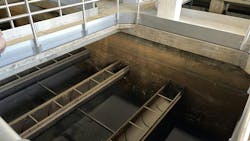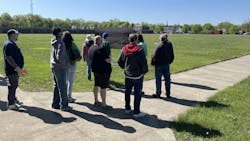From Lake Erie to the tap: How Cleveland gets its drinking water
Water flowing from taps and down drains often goes overlooked and unnoticed. It is a commodity that has faded into our daily lives — it is expected. This is something those of us in the water sector have heard day in and day out.
Drinking Water Week, which occurred from May 4-10 this year, gives residents an opportunity to go behind the scenes to see where their water comes from, how it is treated and how it is distributed. During Drinking Water Week, utilities across the U.S. open their doors and invite locals into their plants.
This year, I headed up to the City of Cleveland Division of Water’s (Cleveland Water) Baldwin Water Treatment Plant. Cleveland Water serves roughly 1.4 million residential, commercial and industrial customers in 80 communities across six counties. According to Cleveland Water, it is the largest supplier of drinking water in the state of Ohio and the tenth-largest municipal water service in the U.S. The facility produces an average of 70 MGD of water.
A history lesson
In June of 2025 the Baldwin WTP turns 100 years old. To understand what makes this such a grand achievement, it is best to understand the history of the city and how the treatment plant came to be.
From December 1, 1885, until 1925, water was sent to Cleveland customers unfiltered from the formerly onsite Fairmount Reservoir. This reservoir consisted of two stone-lined open-air basins holding a combined 80 million gallons. Between 1885 and 1904, water was pumped into the reservoir from the original Division Street Pumping Station.
As the city began to grow, water demand also increased. In 1896, construction began on a 9-foot diameter hand-laid brick tunnel that would extend from the land 5 miles offshore, 50 feet below the bed of Lake Erie, to a new water intake crib.
The 5-Mile Crib, the tunnel, the Kirtland Pump Station and another 4.5 miles of main connecting the pump station to the Fairmont Reservoir went into service in 1904.
In the early 1920s, construction began on the current Baldwin WTP and reservoir, which was designed by architect Herman Kregelius and engineer Joseph Ellms. According to Cleveland Water, the Baldwin Reservoir was the largest covered reservoir in the world at the time and is believed to be the second largest now.
The Fairmount Reservoir was then repurposed from 1925 to 1985 to hold water before it entered the Baldwin WTP for treatment. In 1985, the north basin of the Fairmount Reservoir was converted into a residuals holding facility before the waste was pumped to wastewater treatment.
Beginning in 1990, raw water started being pumped directly from the Kirtland Pumping Station to the Baldwin WTP. Following plant upgrades in 2009, the south basin of the Fairmount Reservoir was filled.
The treatment process
I met up with Alex Margevicius, P.E., commissioner for Division of Water. We hopped through the lines of people eagerly waiting for their tour of the Baldwin WTP. We landed in a grand room of old architecture, vast ceilings and immaculately placed tiles. I was already awe-struck by the facility, which is about to celebrate its 100th birthday.
The 5-Mile Crib and pretreatment
Margevicius explained that the water is sourced from Lake Erie, 5 miles out, from a water intake crib. If you have ever been boating on the lake, you are almost guaranteed to come across the huge orange structure at some point during your trip. Fifty feet beneath the bed of the lake, a 9-foot diameter brick intake tunnel brings the water to land. Close to land, an oxidizing agent is added that helps remove particulates.
Margevicius emphasized the struggle that the workers went through while hand-laying the bricks of the tunnel when construction began in 1896. “Just imagine being down there 50 feet below the lake,” he said.
After screens filter out mussel shells, fish and other larger debris, the water enters the treatment process. The Kirtland Pump Station pulls water through the tunnels and then 4.5 miles uphill to the Baldwin WTP. At the pumps, a substance is added to absorb organic materials that can cause unpleasant tastes and odors. A compound is then added and quickly mixed into the water to help small particles stick together so they can be removed.
The speed water from the pumps then moves into three consecutive tanks, where it is gradually slowed, allowing organic and inorganic material to clump together as floc.
Treatment
Following flocculation, the water then moves to a sedimentation process. The water moves slowly through large settling basins where heavy clumps of floc settle to the bottom and are removed. The floc is pumped to wastewater treatment.
Once through the sedimentation process the water begins filtration.
“The water is pulled through filters made of 2 feet of anthracite over 1 foot of sand,” Margevicius explained. 20 filters are used to remove impurities from the water.
We moved our way through the plant, weaving in and out of all the residents learning about where their water comes from. We ended up overlooking some of the chemical dosing equipment used for disinfection and corrosion prevention. Sodium Hydroxide is dosed for pH adjustment, and Phosphoric Acid is added to help line pipes and prevent lead exposure. Chlorine is also added for disinfection and fluoride is added for teeth.
Margevicius stated that all these processes are computer controlled now with many redundancies. He said that a lot of the processes used to be manual and even showed off some of the original equipment used to manage pumps and filtration.
We made our way outside the treatment plant and down a handful of steps that dropped us out onto a massive open field of grass. Underneath the field sits the Baldwin WTP’s 130-million-gallon finished water reservoir, where the treated water slowly moves through.
The finished product
Before the water can be pumped to the residents around the city, it first has to be tested. Margevicius and I met up with a few of the employees who work in the testing facility and are charged with testing the water. They use both traditional chemical techniques to check for things like chlorine levels, and advanced technologies like handheld sensors for quick, on-site tests. Margevicius stated that the utility can do hundreds upon hundreds of tests per week to ensure the water is safe and that each stage is working as intended.
The treated and finished water then goes to the Fairmount Pump Station, where pressure is increased so the water can make it to residents at higher elevations.
Behind the scenes at Cleveland Water
While walking through the Baldwin WTP, Margevicius allowed me access to the control room, where operators analyze and manage the intricacies of the facility.
The biggest takeaway from my time at the facility was that the staff were excited to be there. Everyone answered my questions with a smile and took time to explain what their job was and how it was performed. This is something I noticed throughout the tour, as residents made their way around the plant, they were always greeted with a friendly face.
Margevicius took the time to walk me through each display, explain the processes of the plant and answer any questions I had. One of the plant operators was eager to show me their updated systems, explain how some of the software works and even showed me his favorite page for analyzing metrics. Two men at the Fairmount Pumping Station walked me around the huge pumps and gave enthusiastic explanations on how the pumps increase pressure to ensure the water makes it to where it needs to go.
All of this, for me, is a reminder that Drinking Water Week isn’t just about where the water comes from, or how it is treated, but it’s about the people behind the scenes who make it all work.
About the Author
Alex Cossin
Associate Editor
Alex Cossin is the associate editor for Waterworld Magazine, Wastewater Digest and Stormwater Solutions, which compose the Endeavor Business Media Water Group. Cossin graduated from Kent State University in 2018 with a Bachelor of Science in Journalism. Cossin can be reached at [email protected].








